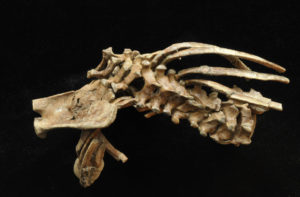A remarkably complete fossil of a young child suggests that key elements of the human spinal structure were already in place in an ancient human relative 3.3 million years ago.
The child, about three years old, likely died suddenly and quickly drifted into a body of water, where she was covered in sediment that eventually hardened to sandstone, Zeray Alemseged of the University of Chicago tells The Two-Way.
His team found the well-preserved fossil in 2000 in Dikika, Ethiopia, and for years they have been painstakingly excavating it, revealing what they say is the only known backbone with completely preserved bones of the middle and upper back dated prior to 60,000 years ago. Their findings were recently published in the Proceedings of the National Academy of Science.
Now, Alemseged says this shows “that the human type of segmentation and numbering of our backbone emerged 3.3 million years ago, and this fossil provides us for the first time the hard evidence, the fossil evidence, to confirm that indeed the structure is as ancient as we’re claiming it now to be.”
The fossil is nicknamed Selam, which means “peace” in Ethiopian Amharic. She is from an early human relative species called Australopithecus afarensis. The famous Lucy fossil is also from this species.
The spines of our early ancestors have been mysterious. They are not well preserved in the fossil record, Alemseged explains, because they are much more fragile than other parts of the animal, like teeth.
This specimen is particularly unique, because it belongs to a child whose individual vertebrae are “still in the process of fusing and forming.” He says that’s why “the data is so unique, shedding light on one of the key milestone events in human evolution and that is the transition from the more ape-like arrangement of the backbone to the more humanlike arrangement of the backbone.”
The specimen has the same number of neck (seven) and mid-back vertebrae (12) as modern humans, while African apes have 13 mid-back vertebrae.
It is well-established that this species walked upright on two legs (though there’s some debate about how much time they spent climbing). But this backbone sheds more light on how they moved.
“The specimen says yes, they had the ability to walk like we do today, like humans, but there are some minor differences,” Alemseged says. “Particularly the transition from the middle part of the backbones to lower part of the backbone, showing that they may have been good walkers, upright like us, but they were clearly not the runners and the endurance walkers that humans are today.”
That’s because they “don’t seem to have the ability to rotate their backbone, even though they had the ability to extend and flex their backbone,” he says.
Scientists spent 13 years working on the fossil at Ethiopia’s National Museum; it later traveled to Grenoble, France, for high-resolution imaging.
“It’s a good example of how much effort you have to put in to get high-quality and reliable information,” says Bernard Wood, a paleoanthropologist at George Washington University who was not involved in the research. “It’s an excellent piece of science.”
He described the fossil found at Dikika as the “gift that keeps on giving,” because its completeness allows researchers to be quite sure about their conclusions. It’s high praise for research on ancient fossils, where findings are often highly controversial.
Richard Potts, the director of Smithsonian’s Human Origins Program, echoed the sentiment, calling it an “excellent job of analysis and interpretation.” At the same time, he stressed that other, less-complete vertebrae, such as fossils found in Sterkfontein, South Africa, have previously suggested that a humanlike species more than 2 million years old had some of the same spinal features.



 May 24th, 2017
May 24th, 2017  Riffin
Riffin 

 Posted in
Posted in  Tags:
Tags: 